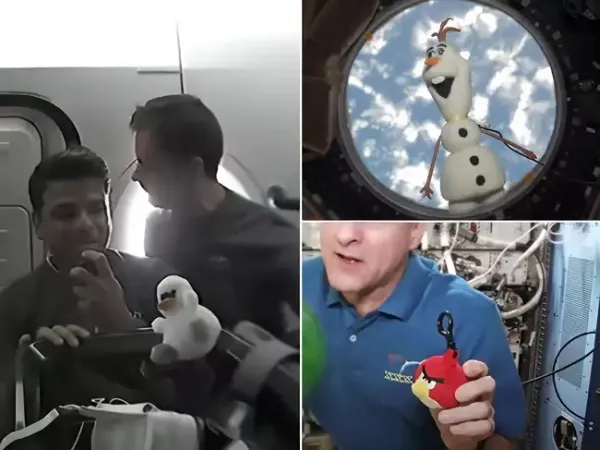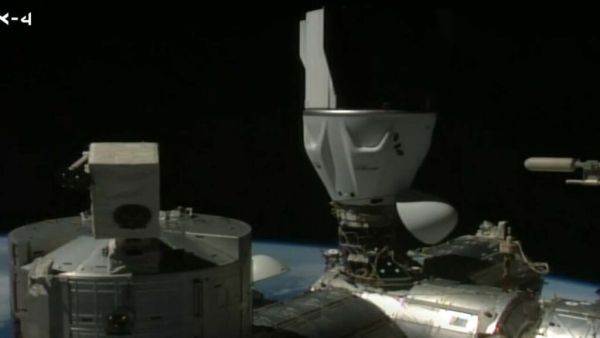When Indian astronaut c greeted the world from space with a namaste and a floating soft toy swan named Joy, it was far more than just a cute interlude. “It looks really cute, but we have a very important swan in Indian culture,” said Shukla in his live broadcast from the International Space Station as part of the Axiom Mission 4. “The swan symbolises wisdom. It also has the ability to discern… what needs to be focused on and what does not,” he explained, making it clear that Joy was not merely an ornamental object but a deeply symbolic choice.
Joy was officially serving as a Zero-G indicator, a now-iconic tradition aboard spaceflights to demonstrate when the spacecraft enters microgravity. These toys, typically suspended near the crew, begin to float as soon as zero gravity kicks in, offering a visual cue that the spacecraft has entered orbit.
Launched aboard a SpaceX Dragon spacecraft from NASA’s Kennedy Space Centre in Florida, Shukla’s mission is the fourth under private space company Axiom’s banner. But while the mission represents a milestone for private spaceflight and international collaboration, it’s the swan that has won hearts on Earth.
In 2012, the “Angry Red Bird” plush from the mobile game Angry Birds was part of a mission to explain physics in space. Olaf from Frozen made it aboard the Soyuz TMA-15M in 2014, courtesy of cosmonaut Anton Shkaplerov fulfilling a promise to his daughter.
Buzz Lightyear, the Toy Story astronaut action figure, travelled aboard Space Shuttle Discovery and remained on the ISS for 15 months. And in recent years, SpaceX has taken the tradition mainstream with Zero-G indicators like a plush Baby Yoda, a penguin named GuinGuin, and a sparkly dinosaur called Tremor.

These aren’t just passengers for show. As NASA’s 2004 “Toys in Space” initiative highlighted, these objects serve as engaging tools to demonstrate how motion, gravity, and physics work differently in microgravity. Japanese astronaut Satoshi Furukawa even built a LEGO model of the ISS while aboard it, bringing childhood pastimes into orbit for educational and scientific purposes.
“We all have some symbolism—in Poland, in Hungary, in India,” Shukla said in his broadcast. “It looks like a coincidence but it’s not. It has more meaning.”
As astronauts continue to push the boundaries of exploration, their Zero-G companions reflect both scientific curiosity and emotional grounding. In Joy, Shubhanshu Shukla has carried not just a symbol of gravity lost, but of wisdom held close.
Joy was officially serving as a Zero-G indicator, a now-iconic tradition aboard spaceflights to demonstrate when the spacecraft enters microgravity. These toys, typically suspended near the crew, begin to float as soon as zero gravity kicks in, offering a visual cue that the spacecraft has entered orbit.
Launched aboard a SpaceX Dragon spacecraft from NASA’s Kennedy Space Centre in Florida, Shukla’s mission is the fourth under private space company Axiom’s banner. But while the mission represents a milestone for private spaceflight and international collaboration, it’s the swan that has won hearts on Earth.
A Long Legacy of Floating Companions
Shukla’s Joy joins a legacy of adorable, meaningful, and sometimes pop-culture-driven soft toys that have soared into the cosmos with astronauts. According to the Copernicus Science Centre, this tradition goes back as far as Yuri Gagarin’s pioneering flight. The first human in space brought along a small doll, beginning a whimsical yet meaningful ritual that continues today.In 2012, the “Angry Red Bird” plush from the mobile game Angry Birds was part of a mission to explain physics in space. Olaf from Frozen made it aboard the Soyuz TMA-15M in 2014, courtesy of cosmonaut Anton Shkaplerov fulfilling a promise to his daughter.
Buzz Lightyear, the Toy Story astronaut action figure, travelled aboard Space Shuttle Discovery and remained on the ISS for 15 months. And in recent years, SpaceX has taken the tradition mainstream with Zero-G indicators like a plush Baby Yoda, a penguin named GuinGuin, and a sparkly dinosaur called Tremor.

SpaceX Zero-G indicators, sparkly dinosaur called Tremor and penguin named GuinGuin. (Images: NASA)
These aren’t just passengers for show. As NASA’s 2004 “Toys in Space” initiative highlighted, these objects serve as engaging tools to demonstrate how motion, gravity, and physics work differently in microgravity. Japanese astronaut Satoshi Furukawa even built a LEGO model of the ISS while aboard it, bringing childhood pastimes into orbit for educational and scientific purposes.
Not Just Toys, but Symbols
Shukla’s choice of a swan connects these floating companions to cultural identity and heritage. While Olaf or Baby Yoda draw on global media icons, Joy represents something uniquely Indian—a cultural motif steeped in ancient philosophy and national symbolism.“We all have some symbolism—in Poland, in Hungary, in India,” Shukla said in his broadcast. “It looks like a coincidence but it’s not. It has more meaning.”
As astronauts continue to push the boundaries of exploration, their Zero-G companions reflect both scientific curiosity and emotional grounding. In Joy, Shubhanshu Shukla has carried not just a symbol of gravity lost, but of wisdom held close.





